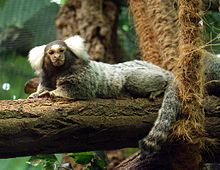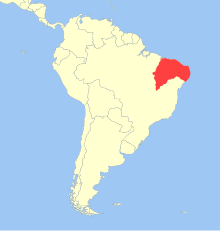
Back Callithrix jacchus AN قشة مألوف Arabic قشه مالوفه ARZ Bejol (Callithrix jacchus) AVK Обикновена мармозетка Bulgarian Callithrix jacchus Breton Callithrix jacchus Catalan Callithrix jacchus CEB Kosman bělovousý Czech Hvidøret silkeabe Danish
| Common marmoset[1][2] | |
|---|---|

| |
| Common marmoset at Aquazoo-Löbbecke-Museum, Düsseldorf | |
| Scientific classification | |
| Domain: | Eukaryota |
| Kingdom: | Animalia |
| Phylum: | Chordata |
| Class: | Mammalia |
| Order: | Primates |
| Suborder: | Haplorhini |
| Infraorder: | Simiiformes |
| Family: | Callitrichidae |
| Genus: | Callithrix |
| Species: | C. jacchus
|
| Binomial name | |
| Callithrix jacchus | |

| |
| Geographic range | |
| Synonyms | |
| |
The common marmoset (Callithrix jacchus), also called white-tufted marmoset or white-tufted-ear marmoset, is a New World monkey. It originally lived on the northeastern coast of Brazil, in the states of Piauí, Paraíba, Ceará, Rio Grande do Norte, Pernambuco, Alagoas, and Bahia.[5] Through release (both intentional and unintentional) of captive individuals, it has expanded its range since the 1920s to Southeast Brazil (its first sighting in the wild for Rio de Janeiro was in 1929), where it became an invasive species, raising concerns about genetic pollution of similar species, such as the buffy-tufted marmoset (Callithrix aurita), and predation upon bird nestlings and eggs.[6]
The whole genome sequence of a female common marmoset was published on 20 July 2014.[7] It became the first New World monkey to have its genome sequenced.[8]
- ^ Groves, C. P. (2005). Wilson, D. E.; Reeder, D. M. (eds.). Mammal Species of the World: A Taxonomic and Geographic Reference (3rd ed.). Baltimore: Johns Hopkins University Press. p. 131. ISBN 0-801-88221-4. OCLC 62265494.
- ^ Rylands AB, Mittermeier RA (2009). "The Diversity of the New World Primates (Platyrrhini)". In Garber PA, Estrada A, Bicca-Marques JC, Heymann EW, Strier KB (eds.). South American Primates: Comparative Perspectives in the Study of Behavior, Ecology, and Conservation. Springer. pp. 23–54. ISBN 978-0-387-78704-6.
- ^ Valença-Montenegro, M.M.; Bezerra, B.M.; Ruiz-Miranda, C.R.; Pereira, D.G.; Miranda, J.M.D.; Bicca-Marques, J.C.; Oliveira, L.; da Cruz, M.A.O.M.; Valle, R.R.; Mittermeier, R.A. (2021). "Callithrix jacchus". IUCN Red List of Threatened Species. 2021: e.T41518A191705043. doi:10.2305/IUCN.UK.2021-1.RLTS.T41518A191705043.en. Retrieved 12 November 2021.
- ^ Linnaeus, Carl (1758). Systema naturæ. Regnum animale (10th ed.). pp. 27, 28. Retrieved 19 November 2012.
- ^ Macdonald, David, ed. (1985). Primates. All the World's Animals. Torstar Books. p. 50. ISBN 978-0-920269-74-9.
- ^ Brandão, Tulio Afflalo (December 2006). "BRA-88: Micos-estrelas dominam selva urbana carioca" (in Portuguese). Rio de Janeiro. Archived from the original on 14 August 2009. Retrieved 10 April 2009.
- ^ Worley, Kim C; Warren, Wesley C; Rogers, Jeffrey; et al. (2014). "The common marmoset genome provides insight into primate biology and evolution". Nat Genet. 46 (8): 850–857. doi:10.1038/ng.3042. PMC 4138798. PMID 25038751.
- ^ Baylor College of Medicine. "Marmoset sequence sheds new light on primate biology and evolution". ScienceDaily. Retrieved 21 July 2014.
